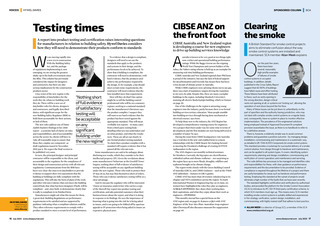


SPONSORED COLUMN CIBSE ANZ on the front foot CIBSE Australia and New Zealand region is developing a course for new engineers to drive up building services knowledge A ustralia is known to be very good at two things right now: cricket and operational building performance ratings. While the Baggy Greens are the reigning World Test Champions and current holders of the Ashes, the Nabers rating scheme is held up as an exemplar for measuring real-time building performance. CIBSE Australia and New Zealand regional chair Phil Senn is proud of the initiative, but says the lack of federal support for decarbonisation until recently has meant there has been a lost decade of climate action in Australia. While CIBSE engineers were advising clients not to use gas, there was a lack of mandatory targets driving the transition to net zero, he adds. Despite this, there are many exemplar buildings in the region, including Murdoch Universitys stunning all-electric Boola Katitjin building, which we feature on page 20. One of the challenges in the region is attracting young engineers into the industry, partly because there is no formal building services tertiary education. Most people stumble into building services through having done mechanical or electrical courses, says Senn. To help those new to the industry, the ANZ Region has developed a comprehensive training course for engineers. Its a project thats been under way for some time in terms of development and the first modules are now being delivered in a number of states he says. Having the team from CIBSE headquarters visit Australia was a real shot in the arm and enabled Senn to cement relationships with the CIBSE Board. Hes looking forward to meeting the Presidents challenge of creating 10 STEM Ambassadors in the region. The ANZ chapters run monthly technical seminars for Members. Currently, the big topics are electrification, embodied carbon and climate resilience not surprising as the region faces up to more floods, droughts, wildfires and typhoons brought on by climate change. The region works closely with the Green Building Council of Australia (GBCA), and CIBSE Guidance such as the TM65 ANZ addendum features in GBCA guides. CIBSE ANZ has more than 20 women volunteering in its chapter and YEN committees across the region. To mark International Women in Engineering Day on 23 June, six women have highlighted the roles they play as engineers. At bit.ly/CJINWED23, they share their working days, their aspirations, and what they enjoy about their work as engineers. #INWED23 This months Journal has a special focus on the ANZ region and, on page 61, features a Q&A with ANZ Engineer of the Year Alex Shan. Australian Arup engineer Jake Cherniayeff also discusses museum fire suppression on page 49. | SCA Clearing the smoke A British Standard for smoke control projects aims to eliminate confusion about the way smoke control systems are installed and maintained. SCA member Allan Meek explains O ver the past few years, there have been several, reasonably high-profile examples of failures of smoke control systems in occupied buildings. In addition, details published in the Cross Safety Report suggest that 60-80% of buildings have failed cause and effect testing. These failures have been attributed to flaws, such as vents opening in the wrong direction, design-critical vents not opening at all, or systems not locking out, allowing the operation of vent doors beyond the fire floor. Many of these issues can be put down to unfamiliarity on the part of specifiers and the authority having jurisdiction, who may not deal with complex smoke control systems on a regular basis and, consequently, have no system in place to monitor effective implementation. The prevalence of fire-engineered solutions being employed instead of Approved Document B-compliant provision exacerbates the issue, as there is no handbook to refer to for a definitive answer. There is, however, a relatively simple way to avoid common problems and guarantee a positive outcome by managing design, installation, commissioning and maintenance in a systematic way, as detailed in BS 7346-8:2013 Components for smoke control systems. This standard provides a routemap for successful delivery of a smoke control solution, from design through to handover and maintenance, and can be applied to all system types. It covers: identifying system requirements; planning and design; installation; commissioning and verification of correct operation; and maintenance and servicing. The code defines key processes to be managed and identifies roles and responsibilities for these, with clear guidance on performance requirements and the documentation to be provided. Evidence of compliance is required throughout the lifetime of a project and there are useful templates for areas such as handover and performance testing. Employing this standard at the outset of projects would eliminate a high number of the faults that we have seen recently. The standard highlights certification and verification by authorised bodies, and provided the platform for the Smoke Control Association (SCA) to introduce its IFC SDI 19 third-party certification scheme, to which SCA members must sign up. This means every SCA member installing smoke control systems is suitably skilled and experienced in fire-strategy verification, system design, installation, and commissioning, with highly trained staff that adhere to best practice. l ALLAN MEEK is a director of Group SCS, a member of the SCA www.smokecontrol.org.uk www.cibsejournal.com July 2023 17